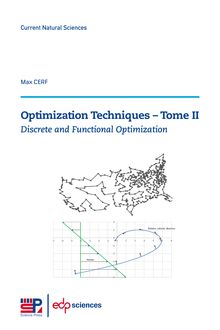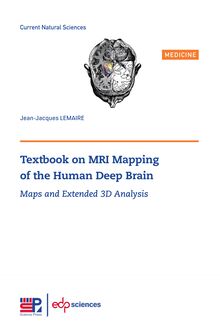-
 Univers
Univers
-
 Ebooks
Ebooks
-
 Livres audio
Livres audio
-
 Presse
Presse
-
 Podcasts
Podcasts
-
 BD
BD
-
 Documents
Documents
-
- Cours
- Révisions
- Ressources pédagogiques
- Sciences de l’éducation
- Manuels scolaires
- Langues
- Travaux de classe
- Annales de BEP
- Etudes supérieures
- Maternelle et primaire
- Fiches de lecture
- Orientation scolaire
- Méthodologie
- Corrigés de devoir
- Annales d’examens et concours
- Annales du bac
- Annales du brevet
- Rapports de stage
La lecture à portée de main
Découvre YouScribe en t'inscrivant gratuitement
Je m'inscrisIntroduction to Louis Michel's lattice geometry through group action , livre ebook
Découvre YouScribe en t'inscrivant gratuitement
Je m'inscrisEn savoir plus
En savoir plus

Description
Group action analysis developed and applied mainly by Louis Michel to the study of N-dimensional periodic lattices is the central subject of the book. Di erent basic mathematical tools currently used for the description of lattice geometry are introduced and illustrated through applications to crystal structures in two- and three-dimensional space, to abstract multi-dimensional lattices and to lattices associated with integrable dynamical systems. Starting from general Delone sets the authors turn to di erent symmetry and topological classi- cations including explicit construction of orbifolds for two- and three-dimensional point and space groups.
Voronoï and Delone cells together with positive quadratic forms and lattice description by root systems are introduced to demonstrate alternative approaches to lattice geometry study. Zonotopes and zonohedral families of 2-, 3-, 4-, 5-dimensional lattices are explicitly visualized using graph theory approach. Along with crystallographic applications, qualitative features of lattices of quantum states appearing for quantum problems associated with classical Hamiltonian integrable dynamical systems are shortly discussed.
The presentation of the material is presented through a number of concrete examples with an extensive use of graphical visualization. The book is aimed at graduated and post-graduate students and young researchers in theoretical physics, dynamical systems, applied mathematics, solid state physics, crystallography, molecular physics, theoretical chemistry, ...
Sujets
Informations
| Publié par | EDP Sciences |
| Date de parution | 08 mars 2016 |
| Nombre de lectures | 0 |
| EAN13 | 9782759819522 |
| Langue | English |
| Poids de l'ouvrage | 6 Mo |
Informations légales : prix de location à la page 0,0005€. Cette information est donnée uniquement à titre indicatif conformément à la législation en vigueur.
Extrait
CURRENT NATURAL CURRENT NATURAL S SCIENCESCIENCES
CURRENT NATURAL SCIENCES
Introduction to Louis Michel’s lattice geometry through group action B. Zhilinskii
CURRENT NATURAL SCIENCES
Introduction to Louis Michel’s
Introduction lattice geometry
through group action to Louis Michel’s
lattice geometry B. Zhilinskii
through group actionroup action analysis developed and applied mainly by Louis Michel to the study of
N-dimensional periodic lattices is the central subject of the book. Di erent basic mathematical tools Gcurrently used for the description of lattice geometry are introduced and illustrated through
applications to crystal structures in two- and three-dimensional space, to abstract multi-dimensional
lattices and to lattices associated with integrable dynamical systems. Starting from general Delone
sets the authors turn to di erent symmetry and topological classi cations including explicit
construction of orbifolds for two- and three-dimensional point and space groups.
Voronoï and Delone cells together with positive quadratic forms and lattice description by root
systems are introduced to demonstrate alternative approaches to lattice geometry study.
Zonotopes and zonohedral families of 2-, 3-, 4-, 5-dimensional lattices are explicitly visualized using
graph theory approach. Along with crystallographic applications, qualitative features of lattices of
quantum states appearing for quantum problems associated with classical Hamiltonian integrable
dynamical systems are shortly discussed.
The presentation of the material is presented through a number of concrete examples with an
extensive use of graphical visualization. The book is aimed at graduated and post-graduate students and
young researchers in theoretical physics, dynamical systems, applied mathematics, solid state physics,
crystallography, molecular physics, theoretical chemistry, ...
Book series edited by Michèle LEDUC and Michel Le BELLAC.
Louis Michel (1923-1999) became in 1962 the rst permanent professor in physics
at l’Institut des Hautes Études Scienti ques in Bures-sur-Yvette, France a world center
of interaction between mathematicians and physicists. In 1984, Louis Michel received
Wigner medal for his contribution to the formulation and use of the symmetry principles.
Boris Zhilinskii worked as researcher at Chemistry department of Moscow State
University (Lomonosov) during 1970-1992. Since 1993 he is professor at Université du Littoral
Côte d’Opale, Dunkerque, France. During 1991-1999 he collaborated with Louis Michel on B. Zhilinskii
application of group-theoretical and topological methods in molecular physics.
69 €
EDP Sciences : 978-2-7598-1738-2
www.edpsciences.org 9 782759817382 CNRS Edition : 978-2-271-08739-3
315X235CollecangCarton.indd 3 28/10/2015 11:53B. Zhilinskii
Introduction to Louis
Michel’s lattice geometry
through group action
CURRENT NATURAL SCIENCES
EDP Sciences/CNRS ÉditionsCover illustration: Rights reserved.
PrintedinFrance
c 2015, EDP Sciences, 17 avenue du Hoggar, BP 112, Parc d’activités
de Courtabœuf, 91944 Les Ulis Cedex A
et
CNRS Éditions, 15, rue Malebranche, 75005 Paris.
This work is subject to copyright. All rights are reserved, whether the whole
or part of the material is concerned, specifically the rights of translation,
reprinting, re-use of illustrations, recitation, broad-casting, reproduction on
microfilms or in other ways, and storage in data bank. Duplication of this
publication or parts thereof is only permitted under the provisions of the
French Copyright law of March 11, 1957. Violations fall under the prosecution
act of the French Copyright law.
ISBN EDP Sciences: 978-2-7598-1738-2
ISBN CNRS Éditions: 978-2-271-08739-3Contents
Preface vii
1 Introduction 1
2 Group action. Basic definitions and examples 5
2.1 Theactionofagrouponitself ................. 12
2.2 Groupactiononvectorspace .................. 16
3 Delone sets and periodic lattices 25
3.1 Delonesets . ........................... 25
3.2 Lattices .............................. 31
3.3 Sublattices of L.......................... 35
3.4 Duallattices. 38
4 Lattice symmetry 43
4.1 Introduction............................ 43
4.2 Pointsymmetryoflattices.................... 43
4.3 Bravaisclasses 46
4.4 Correspondence between Bravais classes and lattice point
symmetrygroups ......................... 50
4.5 Symmetry, stratification, and fundamental domains...... 52
4.5.1 Spherical orbifolds for 3D-point symmetry groups . . 57
4.5.2 Stratification, fundamental domains and orbifolds for
three-dimensional Bravais groups . .......... 62
4.5.3 Fundamental domains for P4/mmm and I4/mmm.63
4.6 Pointsymmetryofhigherdimensionallattices. ........ 69
4.6.1 DetouronEulerfunction ................ 70
4.6.2 Roots of unity, cyclotomic polynomials, and companion
matrices ......................... 71
4.6.3 Crystallographic restrictions on cyclic subgroups of
latticesymmetry..................... 72
4.6.4 Geometricelements ................... 73iv Introduction to lattice geometry through group action
5 Lattices and their Voronoï and Delone cells 81
5.1 Tilings by polytopes: some basic concepts . .......... 81
5.1.1 Two- and three-dimensional parallelotopes ...... 83
5.2 VoronoïcellsandDelonepolytopes ............... 84
5.2.1 PrimitiveDelonesets .................. 88
5.3 Duality .............................. 89
5.4 VoronoïandDelonecellsofpointlattices ........... 90
5.4.1 Voronoïcells ...................... 90
5.4.2 Delonepolytopes .................... 91
5.4.3 Primitivelattices 91
5.5 Classificationofcoronavectors ................. 93
5.5.1 Coronavectorsforlattices ............... 94
5.5.2 The subsets S and F of the set C of corona vectors . 95
5.5.3 A lattice without a basis of minimal vectors . . . . . 99
6 Lattices and positive quadratic forms 101
6.1 Introduction............................ 101
6.2 Twodimensionalquadraticformsandlattices ......... 102
6.2.1 The GL (Z) orbits on C (Q ) ............. 1022 + 2
6.2.2 Graphical representation of GL (Z) transformation on2
theconeofpositivequadraticforms .......... 104
6.2.3 Correspondence between quadratic forms and Voronoï
cells .......................... 109
6.2.4 Reductionoftwovariablequadraticforms ...... 110
6.3 Threedimensionalquadraticformsand3D-lattices 112
6.3.1 Michel’smodelofthe3D-case ............. 113
6.3.2 Constructionofthemodel ............... 116
6.4 ParallelohedraandcellsforN-dimensionallattices. ...... 122
6.4.1 Fourdimensionallattices ................ 128
6.5 Partition of the cone of positive-definite quadratic forms . . . 130
6.6 Zonotopes and zonohedral families of parallelohedra . . . . . 134
6.7 Graphical visualization of members of the zonohedral family 136
6.7.1 From Whitney numbers for graphs to face numbers
forzonotopes....................... 147
6.8 Graphical visualization of non-zonohedral lattices. ...... 148
6.9 OnVoronoïconjecture ...................... 152
7 Root systems and root lattices 153
7.1 Rootsystemsoflatticesandrootlattices ........... 153
7.1.1 Finitegroupsgeneratedbyreflections ......... 156
7.1.2 Point symmetry groups of lattices invariant
byareflectiongroup .................. 159
7.1.3 Orbit scalar products of a lattice ; weights of a root
lattice .......................... 162Contents v
7.2 Latticesoftherootsystems ................... 164
7.2.1 The lattice I ...................... 164n
7.2.2 The lattices D , n ≥ 4 and F ............. 164n 4
∗7.2.3 The D , n ≥ 4 ................. 166n
+7.2.4 The lattices D for even n ≥ 6 ............ 167n
7.2.5 The A ..................... 167n
∗7.2.6 The lattices A 169n
7.3 Lowdimensionalrootlattices .................. 169
8 Comparison of lattice classifications 171
8.1 Geometricandarithmeticclasses ................ 174
8.2 Crystallographicclasses 176
8.3 Enantiomorphism......................... 179
8.4 Timereversalinvariance ..................... 181
8.5 Combining combinatorial and symmetry classification . . . . 183
9 Applications 189
9.1 Sphere packing, covering, and tiling............... 189
9.2 Regularphasesofmatter . ................... 192
9.3 Quasicrystals ........................... 194
9.4 Latticedefects .......................... 194
9.5 Lattices in phase space. Dynamical models. Defects. . . . . . 196
9.6 Modulargroup 202
9.7 LatticesandMorsetheory .................... 206
9.7.1 Morsetheory....................... 207
9.7.2 Symmetry restrictions on the number of extrema . . . 208
A Basic notions of group theory with illustrative examples 211
B Graphs, posets, and topological invariants 223
C Notations for point and crystallographic groups 229
C.1 Two-dimensionalpointgroups.................. 230
C.2 Crystallographicplaneandspacegroups ............ 231
C.3 Notationforfour-dimensionalparallelohedra.......... 231
D Orbit spaces for plane crystallographic groups 235
E Orbit spaces for 3D-irreducible Bravais groups 243
Bibliography 251
Index 259Preface
This book has a rather long and complicated history. One of the authors,
Louis Michel, passed away on the 30 December, 1999. Among a number of
works in progress at that time there were a near complete series of big papers
on “Symmetry, invariants, topology” published soon after in Physics Reports
[75] and a project of a book “Lattice geometry”, started in collaboration with
Marjorie Senechal and Peter Engel [53]. The partially completed version of
the “Lattice geometry” by Louis Michel, Marjorie Senechal and Peter Engel
is available as a IHES preprint version of 2004. In 2011, while starting to
work on the preparation of selected works of Louis Michel [19] it became clear
that scientific ideas of Louis Michel developed over the last thirty years and
related to group action applications in different physical problems are not
really accessible to the young generation of scientists in spite of the fact that
they are published in specialized reviews. It seems that the comment made
by Louis Michel in his 1980’s talk [70] remains valid till now:
“Fifty years ago were p
-
 Univers
Univers
-
 Ebooks
Ebooks
-
 Livres audio
Livres audio
-
 Presse
Presse
-
 Podcasts
Podcasts
-
 BD
BD
-
 Documents
Documents
-
Jeunesse
-
Littérature
-
Ressources professionnelles
-
Santé et bien-être
-
Savoirs
-
Education
-
Loisirs et hobbies
-
Art, musique et cinéma
-
Actualité et débat de société
-
Jeunesse
-
Littérature
-
Ressources professionnelles
-
Santé et bien-être
-
Savoirs
-
Education
-
Loisirs et hobbies
-
Art, musique et cinéma
-
Actualité et débat de société
-
Actualités
-
Lifestyle
-
Presse jeunesse
-
Presse professionnelle
-
Pratique
-
Presse sportive
-
Presse internationale
-
Culture & Médias
-
Action et Aventures
-
Science-fiction et Fantasy
-
Société
-
Jeunesse
-
Littérature
-
Ressources professionnelles
-
Santé et bien-être
-
Savoirs
-
Education
-
Loisirs et hobbies
-
Art, musique et cinéma
-
Actualité et débat de société
- Cours
- Révisions
- Ressources pédagogiques
- Sciences de l’éducation
- Manuels scolaires
- Langues
- Travaux de classe
- Annales de BEP
- Etudes supérieures
- Maternelle et primaire
- Fiches de lecture
- Orientation scolaire
- Méthodologie
- Corrigés de devoir
- Annales d’examens et concours
- Annales du bac
- Annales du brevet
- Rapports de stage




















